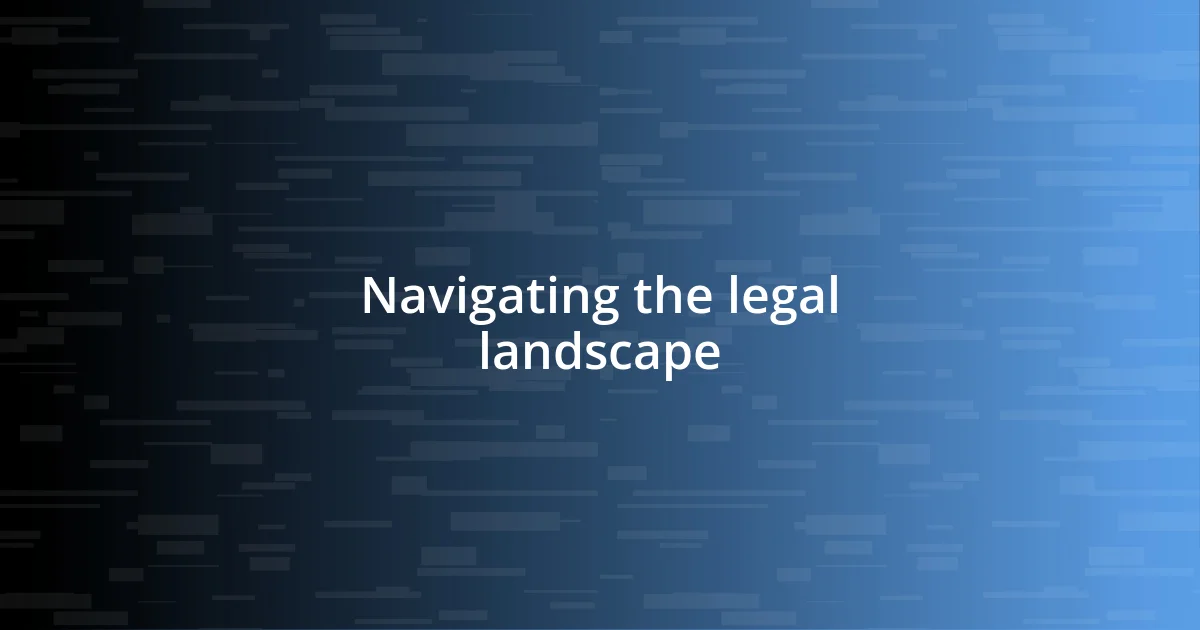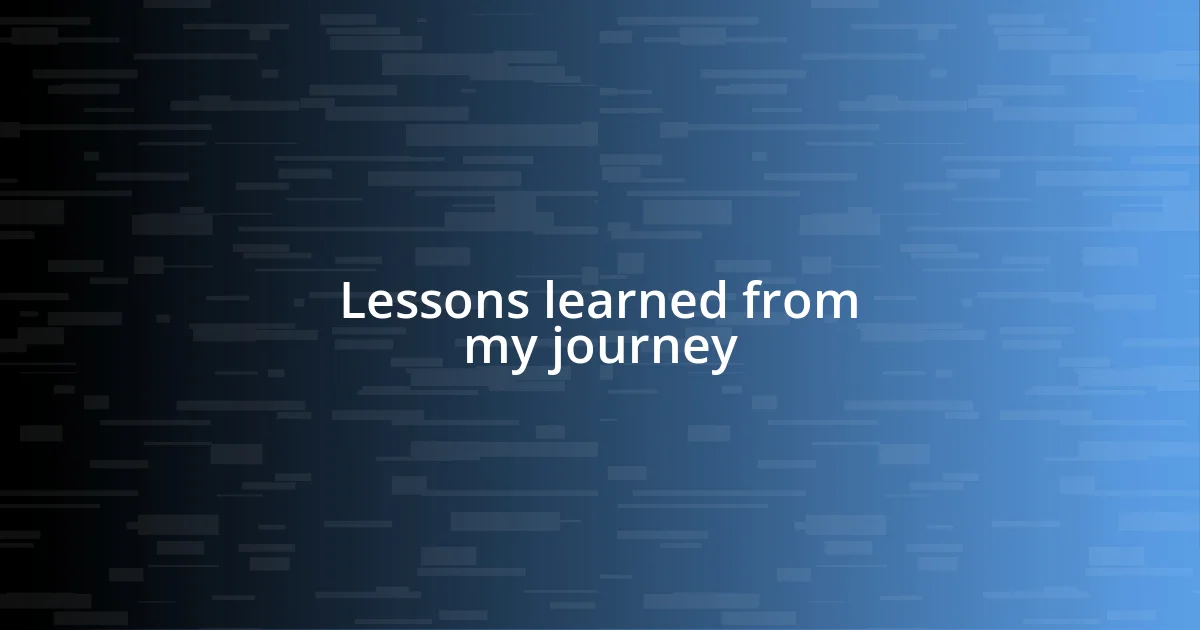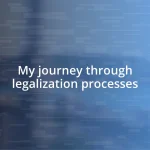Key takeaways:
- The 2018 Farm Bill legalized hemp-derived CBD federally, significantly impacting consumer access and business opportunities, yet state regulations vary widely.
- Engaging policymakers through personal stories and clear communication fosters understanding and empathy, leading to more informed legislative decisions.
- Future public policy on CBD is likely to evolve towards a more balanced regulatory framework, driven by collaboration among stakeholders and increased research into its benefits.

Understanding public policy on CBD
Public policy surrounding CBD has evolved rapidly, yet many people still find it complex and confusing. I remember feeling overwhelmed by the sheer volume of regulations and varying state laws when I first started exploring this topic. Isn’t it frustrating when regulations don’t seem to keep up with public interest?
One key aspect to understand is that public policy on CBD often reflects broader societal attitudes toward cannabis. I’ve seen firsthand how shifting perceptions about hemp-derived products influence legislation. Have you ever wondered how a plant with such deep historical roots can suddenly become the center of contemporary debate?
As I dove deeper into the policies affecting CBD, I realized how interwoven it is with issues of health, safety, and economic opportunity. For instance, while researching local laws, I found out about regulations designed to protect consumers and encourage responsible development in the industry. It made me think—how do we balance innovation with safety in such a rapidly evolving market?

My initial interests in CBD
When I first heard about CBD, I was curious but cautious. I remember sitting at my kitchen table, sipping a cup of chamomile tea, and reading about its potential therapeutic benefits. The more I learned, the more fascinated I became, especially when I discovered stories of individuals finding relief from ailments like anxiety and chronic pain. It was a blend of hope and skepticism that really drew me in.
Here’s what particularly piqued my interest in CBD:
– Natural remedies: I’ve always been intrigued by alternatives to traditional medicine, so CBD’s natural origins resonated with me.
– Personal stories: Hearing testimonials from people who experienced life-changing results fueled my desire to dive deeper into the subject.
– Research potential: The scientific studies illustrating CBD’s effects sparked my ambition to understand the research landscape better.
This journey wasn’t just about the facts; it was about connecting with a community passionate about health and wellness. Each piece of information felt like a personal invitation to explore this evolving realm further.

Key regulations affecting CBD
One of the most significant regulations affecting CBD is the 2018 Farm Bill, which legalized hemp-derived CBD at the federal level, provided it contains less than 0.3% THC. This was a game-changer. I remember celebrating this moment, as it opened up a treasure trove of opportunities for businesses and consumers alike. The confusion over THC levels used to be daunting, but knowing the federal definition brought a degree of clarity to the chaos.
State regulations, however, present a patchwork of rules that can be quite confusing. For example, while some states fully embrace CBD, others impose strict limitations or outright bans. I often found myself scratching my head, trying to navigate the differences in rules across state lines. Isn’t it interesting how something can be deemed legal in one place and illegal just a few miles away? That realization added to my appreciation for well-crafted policy aimed at consumer safety.
In addition to these main regulations, marketing claims surrounding CBD are also tightly regulated by the FDA. I vividly recall the day I stumbled upon a misleading advertisement claiming that CBD could cure all ailments. It reminded me how crucial it is for regulations to ensure consumers are protected from false promises. Striking a balance between promoting innovation and safeguarding public health feels like walking a tightrope—one that requires careful consideration and robust dialogue among stakeholders.
| Regulation | Key Points |
|---|---|
| 2018 Farm Bill | Legalizes hemp-derived CBD; <0.3% THC |
| State Regulations | Varies widely; some states embrace, others restrict |
| FDA Guidelines | Regulates marketing claims; ensures consumer safety |

Navigating the legal landscape
As I delved deeper into the legal landscape of CBD, I often found myself feeling overwhelmed. Just thinking about the myriad of laws was daunting! I recall standing in my local dispensary, scanning the shelves filled with CBD products, and wondering whether the options I saw were compliant with state regulations. Each product felt like a gamble, and it made me realize how vital it is for consumers to educate themselves amid such complexity.
Navigating state regulations was another rollercoaster experience. I remember a trip to a nearby state where CBD was still heavily restricted. It hit me hard when I found my favorite oil was suddenly illegal. That moment made it clear how important local laws can be in shaping access to CBD. It really brought to life the challenges that both consumers and businesses face in this ever-shifting legal terrain. Have you ever found something perfect for you just to discover it’s not available in your area? It’s a frustrating reminder of how crucial it is to stay informed.
Throughout my journey, I’ve seen firsthand how fostering open dialogues among lawmakers, businesses, and consumers can pave the way toward a more coherent legal framework for CBD. I had a chance to participate in a local community meeting where stakeholders discussed these issues, and it was eye-opening. The passion and concern for public safety and access were palpable. It made me reflect on how effective public policy can not only empower individuals but also nurture a thriving industry, creating a win-win scenario for everyone involved.

Engaging with policymakers effectively
Engaging with policymakers effectively requires not just a clear message, but also a genuine connection. I remember my first meeting with a local representative about CBD regulations. Instead of jumping straight to statistics, I chose to share a personal story about how CBD had positively impacted my life. The look of understanding on the policymaker’s face reminded me that behind every decision, there are real people who want to understand the real-world impact of their policies.
Listening is just as crucial as sharing my experience. During another engagement, I observed how attentive lawmakers were when constituents voiced their concerns. It struck me that when we introduce our stories, we aren’t merely presenting data; we’re creating an emotional landscape in which policymakers can see the human side of legislation. This approach fosters empathy, paving the way for more informed decisions. How often do we overlook this vital component in discussions about policy?
Persistence is key. Following that initial meeting, I made it a point to follow up, sharing additional research and success stories from community members. Each email felt like planting a seed, reminding policymakers that the conversation didn’t end after our first interaction. I learned that cultivating these relationships over time builds trust, allowing for a more fruitful dialogue about the critical issues surrounding CBD. Wouldn’t you agree that ongoing engagement amplifies our voices and enhances the likelihood of transformative policies?

Lessons learned from my journey
One of the biggest lessons I learned was the power of community support. During a local rally advocating for CBD access, I was taken aback by the sheer number of individuals who had their own stories about CBD’s benefits. Their passion energized me, and I realized that fostering these connections creates a robust network that can influence policy effectively. Have you ever felt like your voice could change something larger than yourself? That experience solidified a belief in collective action for reform.
Another important insight was the need for clear communication. There were times I grappled to articulate the science behind CBD’s efficacy to policymakers who weren’t well-versed in it. I vividly recall a meeting where I struggled to simplify complex concepts, and it hit me: If I couldn’t explain it clearly, how could I expect them to understand its value? This reinforced my commitment to translating technical details into relatable language. Have you ever found yourself caught in jargon that alienated your audience?
Moreover, the importance of personal resilience became crystal clear. There were certainly setbacks—a proposed bill I fervently supported failed to pass, leaving me disheartened. Yet, instead of giving up, I channeled that disappointment into determination. I learned to adapt my approach, seeking new allies and avenues. It’s true what they say: every setback can be a setup for a comeback. There’s a unique strength in learning from challenges, don’t you think?

Future of public policy on CBD
As I think about the future of public policy on CBD, I can’t help but feel a wave of optimism. With increasing research supporting its benefits, I foresee a more educated approach from lawmakers. I remember a conversation I had with a legislator who was initially skeptical about CBD. After reviewing the latest studies I provided, they expressed a willingness to rethink their stance. This shift in perspective highlights the potential for informed discussions to shape a promising policy landscape.
Looking ahead, I believe collaboration among stakeholders will play a crucial role. My experience at a recent conference revealed how advocacy groups, researchers, and industry representatives can come together to push for concrete change. The passion and expertise everyone brought to the table sparked dynamic conversations. Have you ever felt that collaborative energy? It’s contagious, and it acts as a powerful catalyst for creating comprehensive policies that can address both public health and economic opportunities.
Ultimately, I foresee a more nuanced regulatory framework for CBD emerging. Policymakers will need to strike a balance between public safety and accessibility. I’ve often pondered how regulations might evolve in response to ongoing societal shifts, such as the growing demand for natural health alternatives. If lawmakers actively engage with the community—actually listening to our stories—they can craft policies that are not just well-intentioned but genuinely effective. After all, isn’t the goal to foster an environment where everyone’s voice matters?














